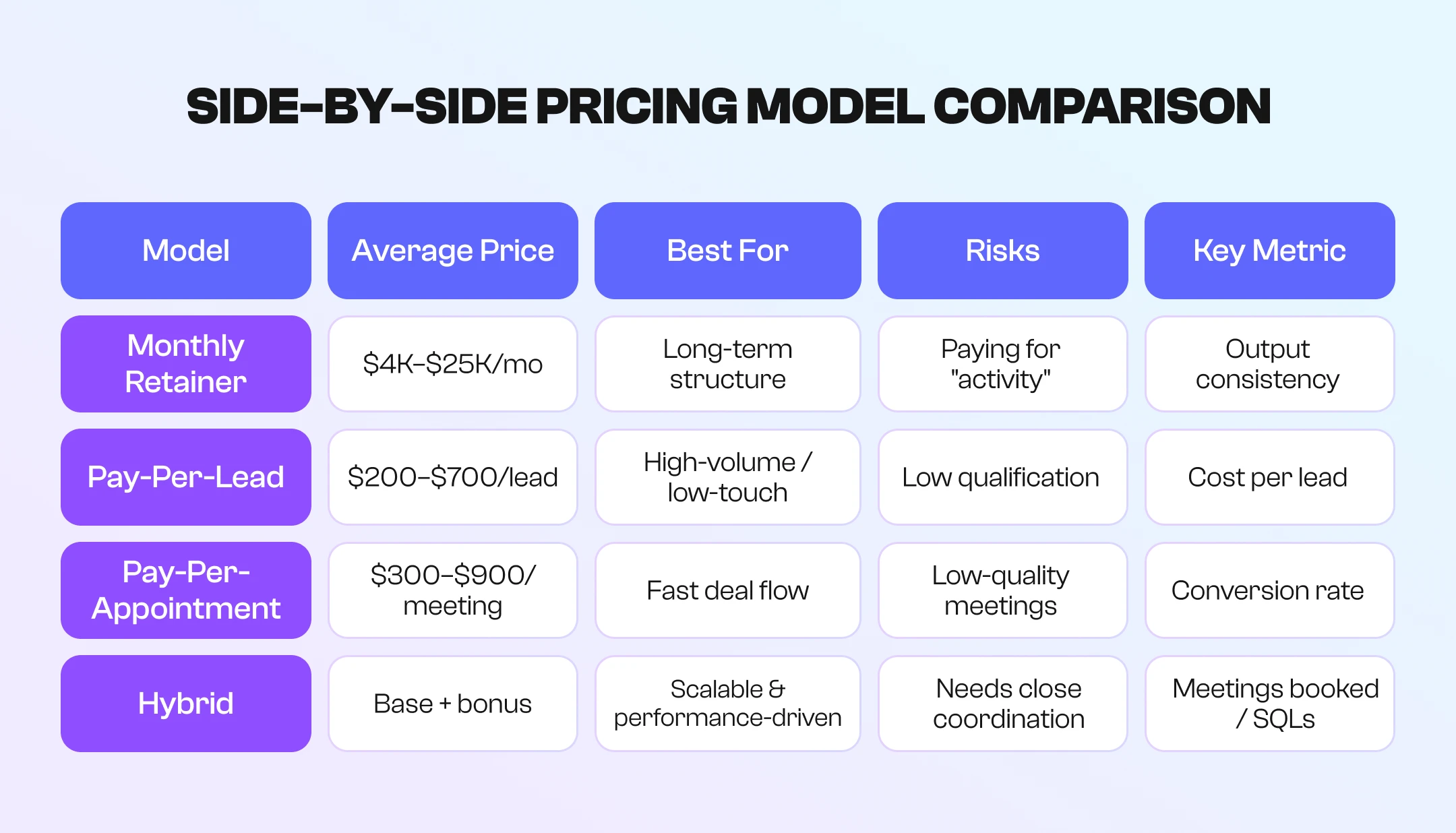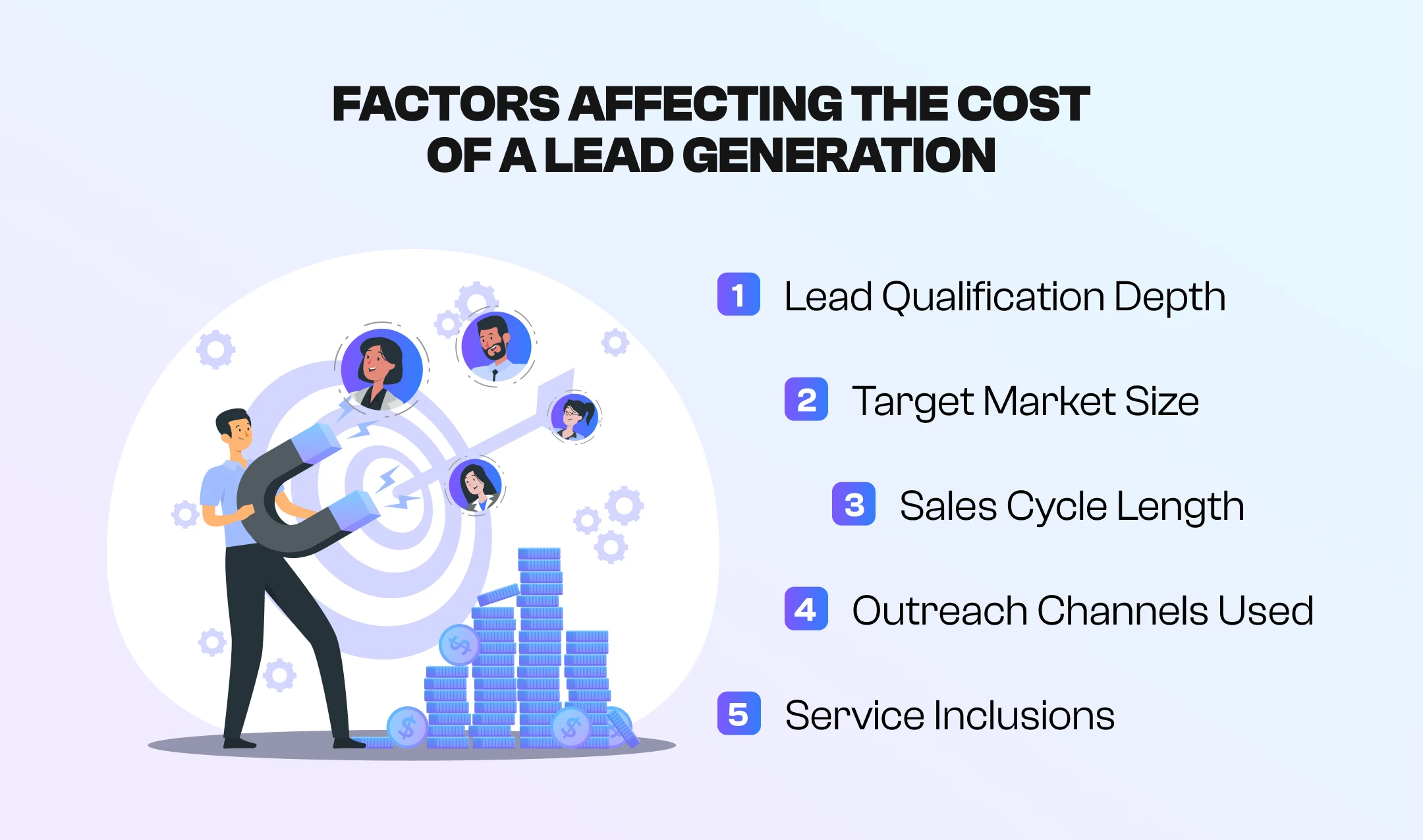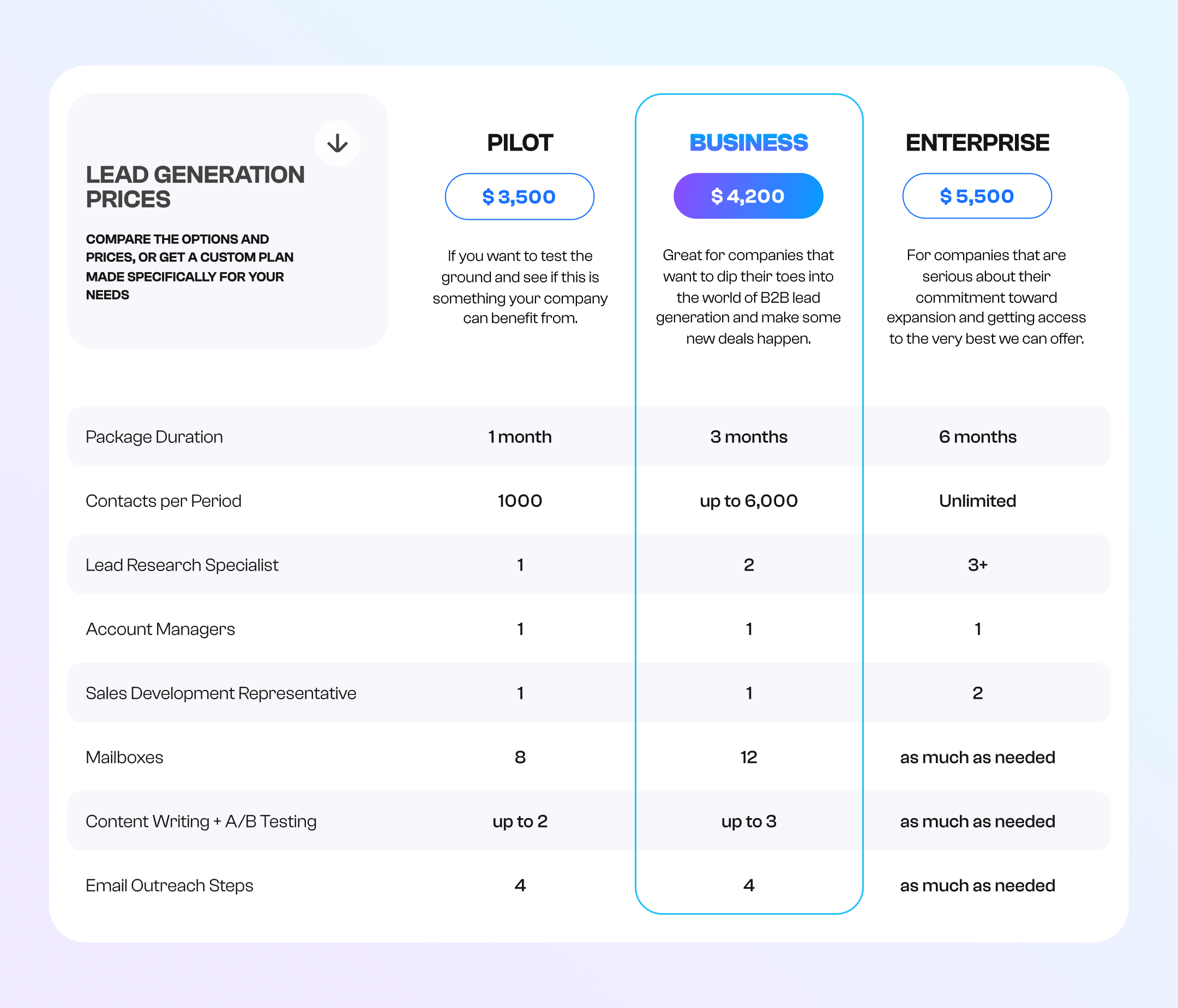Not long ago, a SaaS startup knocked on our door. They had a smart team, a great product, and fresh funding. But their faces said it all—frustration, disappointment, and a little panic.
They had just spent $30,000 on a lead generation agency that promised the moon. In return? A handful of low-quality leads that went nowhere. Not a single deal closed. When we looked at what had been done, it was clear: the agency ran a spray-and-pray email campaign with no real targeting, personalization, or follow-up strategy.
They went with the hybrid pricing model, but didn’t get any results.
If you’re considering working with a lead generation agency to scale your outreach, make sure you’re partnering with a team that understands your market, not just metrics.
This article isn’t about selling you a service—it’s about helping you avoid the pitfalls we’ve seen across hundreds of B2B lead generation campaigns. It’s about helping you avoid mistakes I’ve seen again and again. Let’s break down what you’re truly getting with your lead generation pricing—and whether it’s aligned with outcomes that matter.
- How Much Does Lead Generation Cost?
- Understanding Pricing Models That Drive B2B Growth
- What Lead Gen Really Costs in Your Industry
- Why Prices Vary: The 5 Factors That Drive Cost
- Choosing the Right Model for Your Business
- Real Numbers: What Should You Budget for Lead Generation?
- How to Get ROI from Your Lead Gen Spend
- Conclusion: You’re Not Paying for Leads. You’re Investing in Growth
How Much Does Lead Generation Cost?
The landscape regarding lead generation pricing is confusing. Prices range from a few hundred dollars a month to tens of thousands, depending on the model. You’ll see offers from $500/month to $20,000+/month. Some charge per lead, some charge per campaign, and others bundle lead generation into full sales development packages. So how do you know if the lead generation price you’re quoted is fair—or just a flashy number with little substance?
Here’s a quick breakdown of the most common models:
- Cost-per-lead (CPL): Pay for each lead delivered. Rates vary wildly—anywhere from $25 to $500+, depending on industry and lead quality.
- Monthly retainer: Fixed fee for ongoing services, often between $2,000 and $15,000/month.
- Performance-based: You pay based on meetings booked or revenue generated. Sounds great, but it usually comes with a higher price tag or lower quality.
In B2B lead generation, it’s not just about getting leads—it’s about getting the right ones through a model that supports your revenue motion. The biggest issue is that most companies don’t understand what they’re buying—leads, yes, but what kind? How are they sourced? Before you compare lead generation prices, ask: are these leads truly qualified, or are you paying for raw data?
You don’t want cheap leads. You want effective leads.
Understanding Pricing Models That Drive B2B Growth
Over the years, we’ve tested every pricing model you can imagine—some work great, but others are traps in disguise. The right model depends on your goals, the team’s internal capacity, and risk tolerance. But no matter what, it should align with actual revenue impact—not vanity metrics. Here’s how the most common lead generation pricing models work—and where they deliver (or fall flat).

Monthly Retainers
If you’re thinking long-term and want a full-service approach—strategy, research, outreach, and appointment setting—retainers are usually the way to go. If you need to pay for appointments to speed up the pipeline during growth phases, track conversions, not just meetings booked.
The common range here is $4,000 to $25,000 per month, depending on complexity, scale, and the size of your addressable market.
In B2B lead generation, ongoing retainers can drive growth—but only when matched with clear KPIs and strategic outreach. Too many businesses pay for months of “activity” without a real result. Without clear accountability, even a high lead generation price can lead to a wasted budget compared to booked meetings.
65% of B2B agencies rely on retainers as their primary pricing structure (HubSpot, 2023). Why? Because they allow agencies to plan and deliver consistent output. But it only works when there’s accountability baked in. If you’re going down this road, set milestones and make sure both sides stay accountable.
Pay-Per-Lead
It sounds appealing—simple, transactional, and measurable. You pay for each lead delivered—no fluff.
The reality? It’s often a bait-and-switch.
The average lead generation price per lead ranges from $200 to $700, but this often only covers basic contact data, not sales-ready opportunities.
“This model often sounds better than it performs,” I tell clients. “You’re not paying for pipeline—you’re paying for inbox clutter unless the vendor is doing real qualification.”
Without personalization or targeting, the lead generation price per lead might not be worth it, no matter how low the offer. Low-quality B2B lead generation campaigns often deliver a fancy spreadsheet instead of a healthy pipeline.
Without proper qualification, the lead generation price per lead turns into a cost per distraction, not value.
Pay-Per-Appointment
Companies that pay for appointments often see better outcomes when targeting and messaging are done right from the start. It shifts the focus from vanity metrics to outcomes that matter: real conversations with real prospects.
Lead generation pricing for pay-per-appointment models typically ranges between $300 and $900 per meeting, depending on complexity and buyer persona.
One of our fintech clients used this model during their Series A push. They had a lean sales team, no time for trial and error, and needed qualified meetings fast. Over six months, they closed five enterprise clients from 42 booked meetings—all sourced through a pay-per-appointment model. It worked because the targeting was tight, the messaging was on point, and the qualification process was handled before the meeting hit their calendar. This fintech client’s success story proves you can safely pay for appointments when the entire funnel is tailored and thoughtful.
This pricing model works great when done right. But if it’s cheap and fast with zero transparency, it’s not transparent. If you’re going to pay for appointments, make sure there’s real qualification—otherwise, you’re buying time-wasters, not buyers.
Hybrid Pricing
This is the flexible middle ground—our most popular model at SalesAR.
You start with a base fee that covers foundational work: ICP research, campaign setup, list building, and messaging. Then there’s a performance bonus tied to results—meetings booked, SQLs delivered, whatever metric you choose.
“This model keeps everyone accountable,” I always say. It ensures the vendor doesn’t just send emails—they’re focused on driving outcomes. And for clients, there’s skin in the game. Whether you choose a hybrid setup or decide to pay for appointments, what matters is working with a partner focused on delivering measurable results—not just activity.
The hybrid pricing model also works well for companies that want structure without locking into rigid terms. It scales up or down depending on what’s working, and that kind of flexibility makes a big difference when you’re growing fast.
What Lead Gen Really Costs in Your Industry
One of the first things clients ask me is: “What should I expect to pay in my industry?”
Fair question—and the answer depends on your audience, your sales cycle, and how much qualification your leads need before they’re sales-ready. Some fields need volume. Others need surgical precision. Here’s what I usually tell them, based on real-world benchmarks and what we’ve seen across hundreds of campaigns.
SaaS / Tech
If you’re in SaaS, you’re likely battling long sales cycles, many decision-makers, and highly informed buyers. That means your lead gen needs to do more than just fill out a spreadsheet—it has to nurture interest and educate early.
Average retainer: $8,000–$20,000/month
Average cost-per-lead (CPL): $400–$700
These leads aren’t easy to come by. You’re investing in deeper personalization, multi-step outreach, and often technical content to get in the door. But if you do it right, the ROI compounds fast, especially for recurring revenue models.
Healthcare / MedTech
This one’s a beast. Between HIPAA compliance, industry regulations, and the need to build trust before any conversation starts, healthcare and MedTech are some of the toughest verticals to crack.
Average retainer: $6,000–$15,000/month
“HIPAA compliance, narrow targeting, and trust-building make this one of the most complex verticals,” I often tell clients. You need messaging that resonates with both decision-makers and frontline users—and in many cases, you’re also selling across multiple departments. A solid campaign here takes time, patience, and serious precision.
Financial Services
Finance isn’t just about data—it’s about reputation. In this industry, trust is everything, which makes outbound lead generation more delicate than most. You can’t afford to look generic or pushy.
Average CPL: $350–$800
You’ll need deep qualification, thoughtful messaging, and, ideally, a warm intro or social proof built in. A good lead gen partner here focuses on quality over quantity, because one closed deal can easily be worth six figures or more.
Industrial / Manufacturing
These industries aren’t flashy—but they’re consistent. You won’t see massive lead volume, but that’s not the point. Here, targeting is everything. You’re selling to specific roles in specific regions with specific needs.
Average CPL: $150–$400
“It’s not about volume—it’s about precision,” I remind clients in this space. If your provider can’t understand the nuances of your machinery, materials, or distribution chain, they’ll burn time and budget fast. The best results come from tailored campaigns that speak the language of the shop floor and the boardroom.
Professional Services
Law firms. Consulting. Agencies. Here, it’s less about outreach scale and more about personalization and trust. You’re often targeting C-level buyers with high expectations and even higher skepticism.
Custom pricing is common because every engagement is different. In high-trust verticals like legal or consulting, B2B lead generation requires a surgical level of personalization to build credibility.
If pricing sounds too low in this space, you’ll lose credibility before the first call is even booked.
Outreach in B2B lead generation—especially in services—is about building rapport, not blasting generic offers. You’re building a relationship, not just booking a call. According to Gartner, 77% of B2B buyers say their latest purchase was “very complex or difficult.” That’s even more true for services, where buyers often invest in people, not just products.
Why Prices Vary: The 5 Factors That Drive Cost
Sometimes, people say, “Why does one agency charge $3K and another $15K for the same thing?” But it’s never the same thing. Not even close.
Lead generation pricing isn’t random—it reflects research depth, outreach quality, and how well the service aligns with your revenue goals. Understanding the structure behind lead generation prices helps avoid surprises and sets expectations for real performance.

1. Lead Qualification Depth
Are you just getting names and email addresses? Or are you getting prospects who’ve been researched, pre-screened, and matched to your ICP with care?
The deeper the qualification, the higher the price—and the better your close rate. Surface-level leads are cheap for a reason. You’ll spend that savings (and more) on your sales team chasing dead ends.
2. Target Market Size
Niche targeting costs more. There are only so many if you’re going after CFOs at Fortune 500s. That means the research is manual, the messaging must be high-touch, and the margin for error is thin.
While broader outreach may lower your lead generation price per lead, it often sacrifices the quality needed to convert.
3. Sales Cycle Length
The longer your sales cycle, the more nurturing is required. One cold email won’t cut it. You need sequenced messaging, retargeting, follow-ups, and sometimes months of engagement just to book a meeting.
The more touchpoints, the more hours and tools involved, which is reflected in your pricing.
4. Outreach Channels Used
Email only? Or are you layering in LinkedIn, phone, paid ads, or direct mail?
The more channels you use and thoughtfully layer, the greater your chances of making your campaign stand out. However, it takes more resources to run properly. Multichannel works better, but it isn’t plug-and-play.
5. Service Inclusions
This is the sneaky one. Two agencies might pitch the same service, but one includes data enrichment, messaging strategy, A/B testing, and appointment setting—and the other just pulls a list and hits “send.”
Good copywriting alone can make or break a campaign. The best providers treat it like sales writing, not spam.
So when you compare prices, compare what’s inside the box—not just the label.
Choosing the Right Model for Your Business
Here’s the part no one wants to admit: there’s no single “best” pricing model. Different lead generation pricing models suit different business stages, but the best one always connects cost to measurable ROI.
When clients ask me what to pick, I walk them through a simple checklist. And yeah, it sounds basic—but it saves people from wasting tens of thousands of dollars.
Ask yourself:
- What’s your current close rate from outbound leads?
- Do you have a sales team to follow up and nurture those leads?
- Are you optimizing for lead quantity or lead quality?
- Do you need a fast pipeline, or are you building long-term growth?
- Can you handle fluctuating lead volume, or do you need consistency?
Need Help Choosing the Right Model?
We’ve made it easy if you’re unsure which pricing structure fits your growth stage.
Explore our lead generation packages to see how we tailor lead gen solutions for early-stage startups, growing SaaS teams, and enterprise players.
Every package includes full transparency, detailed breakdowns, and a focus on measurable outcomes — not just empty activity.
Here’s what SalesAR offers, clearly laid out:

Still unsure? Let the results speak. Browse our case studies to see how we’ve helped companies across industries scale their outbound efforts and close real deals — with real ROI.
Now, here’s how to think about each model in that context:
- Monthly Retainer: Best when you want consistency and build a long-term outbound engine. If you have a sales team and a clear ICP, retainers give you structure and scale.
- Pay-Per-Lead: Works for high-volume, low-touch sales, like SMB SaaS or transactional services. However, it is not ideal for complex B2B sales, where lead quality matters more than quantity.
- Hybrid: This is ideal if you’re ready to scale but want built-in accountability. Base fees keep the engine running, and performance incentives keep everyone focused on outcomes.
One of our clients—a boutique consulting firm—started with pay-per-lead. The volume was decent, but conversions were low. Their team was spending too much time qualifying junk leads.
We shifted them to a hybrid model: a smaller base fee with bonus payments tied to meeting with decision-makers in their target vertical. We tightened targeting, improved messaging, and added LinkedIn outreach.
Switching lead generation pricing models helped them triple their conversion rate within three months—proof that the right structure matters. The same budget means better results because the model finally matches their strategy.
Real Numbers: What Should You Budget for Lead Generation?
To make smart decisions about your lead generation pricing, you need to understand what that spend includes—and what kind of results it should drive.
I constantly get this question: “What should we expect to spend?” While no two campaigns are identical, there are ballpark ranges you can use as a starting point.
Starter Campaigns (SMBs, Narrow Targeting)
$3,000–$7,000/month
Perfect if you’re early-stage, with a clear niche audience and a simple outreach plan (usually email only). This is where most companies start testing the waters, and it’s a solid entry point if expectations are realistic.
Growth Campaigns (Mid-Market, Multi-Channel)
$8,000–$15,000/month
This is where things get more serious. You’re layering in LinkedIn, improving personalization, running A/B tests, and refining messaging based on data. These campaigns generate a real pipeline and require coordination between your marketing and sales teams.
Enterprise Campaigns (Global Reach, Custom Data)
$15,000–$30,000+/month
These campaigns target multiple markets, often with multilingual outreach, deep data enrichment, and full-funnel reporting. These premium campaigns come with a higher lead generation price, but the return—enterprise meetings and six-figure deals—justifies the spend.
Here’s how I usually frame it:
Don’t just ask “What’s the cost?”
Ask: “What’s the cost of inaction?”
If your competitors are booking meetings, building relationships, and owning mindshare—how much are you losing by waiting?
Lead generation isn’t just a budget item. It’s a growth lever. Pull it right, and it pays for itself many times over.
Review our full lead generation pricing packages to find the model that fits your goals.
How to Get ROI from Your Lead Gen Spend
Throwing money at lead gen won’t get you results—strategy will. The clients who see real ROI aren’t just writing checks and waiting for magic. They treat lead generation as an active, evolving part of their business. It’s not about ticking boxes—it’s about building a repeatable system that fuels growth.
So, how do you ensure your investment turns into pipeline and closed deals? Here’s what separates the winners from the disappointed.
Align Marketing and Sales
If your marketing team generates leads your sales team won’t touch, you’re burning the budget. This happens more often than you’d think. Misalignment in targeting, qualification, or even follow-up timing can quietly kill your ROI.
Sit both teams down and agree on what qualified means. Are you going after C-level execs or department heads? Do you care more about the industry, company size, or tech stack? Everyone needs to be on the same page.
When marketing and sales are in sync, messaging is sharper, follow-ups are faster, and conversions climb.
Use Data to Iterate and Improve
Lead gen isn’t “set it and forget it.” The best campaigns evolve. You might start with a solid idea of your ICP and outreach strategy, but the data will tell you what’s working.
What subject lines are driving replies? Which personas are converting at higher rates? Are you seeing more success with LinkedIn, or is cold email still your best channel? These kinds of insights let you double down on what’s working and cut what’s not.
Refining your outreach every month—even every week—turns a decent campaign into a high-performing one. And the compounding effect over time? That’s where real ROI comes from.
Define What a “Qualified Lead” Means to You
It sounds obvious, but you’d be surprised how often this step is skipped. One company defines a qualified lead as “someone who booked a meeting.” Another says, “They need to have a budget, decision-making power, and intent to buy within 90 days.”
If you don’t define this upfront—with your internal team and lead gen partner—you’ll get leads that technically meet a vague requirement but won’t convert.
In B2B lead generation, clear alignment between sales and marketing is essential to convert opportunities into pipeline.
“Our most successful clients treat lead gen as a growth engine—not a one-time fix,” I always tell prospects.
Because that’s what it is. It’s not a campaign you run once and move on. But a foundational piece of your sales strategy that consistently brings you real conversations with real buyers.
Treat it like a long-term investment, stay involved, and keep optimizing. That’s how you win.
Conclusion: You’re Not Paying for Leads. You’re Investing in Growth
B2B lead generation works best when treated as a long-term engine, not a one-time campaign or quick fix.
It fills your pipeline, fuels your sales team, and drives the revenue that keeps the business moving forward.
Every campaign you launch and dollar you spend feeds into the bigger goal: sustainable growth. And when done right, lead gen doesn’t just pay for itself. When planned strategically, even a premium lead generation price can become one of the highest ROI investments in your go-to-market strategy.
So spend wisely, choose the right model, demand accountability, and, above all, treat lead gen like the engine it is, not just for today’s revenue targets but for the future you’re building.


